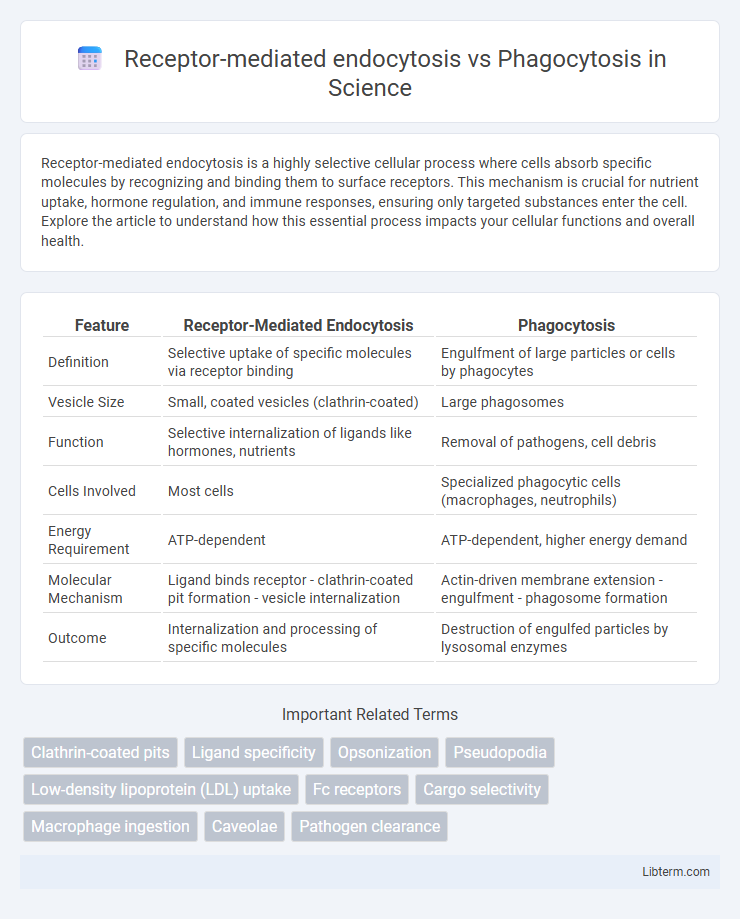Receptor-mediated endocytosis is a highly selective cellular process where cells absorb specific molecules by recognizing and binding them to surface receptors. This mechanism is crucial for nutrient uptake, hormone regulation, and immune responses, ensuring only targeted substances enter the cell. Explore the article to understand how this essential process impacts your cellular functions and overall health.
Table of Comparison
| Feature | Receptor-Mediated Endocytosis | Phagocytosis |
|---|---|---|
| Definition | Selective uptake of specific molecules via receptor binding | Engulfment of large particles or cells by phagocytes |
| Vesicle Size | Small, coated vesicles (clathrin-coated) | Large phagosomes |
| Function | Selective internalization of ligands like hormones, nutrients | Removal of pathogens, cell debris |
| Cells Involved | Most cells | Specialized phagocytic cells (macrophages, neutrophils) |
| Energy Requirement | ATP-dependent | ATP-dependent, higher energy demand |
| Molecular Mechanism | Ligand binds receptor - clathrin-coated pit formation - vesicle internalization | Actin-driven membrane extension - engulfment - phagosome formation |
| Outcome | Internalization and processing of specific molecules | Destruction of engulfed particles by lysosomal enzymes |
Introduction to Cellular Uptake Mechanisms
Receptor-mediated endocytosis is a selective cellular uptake mechanism where specific ligands bind to cell surface receptors, triggering vesicle formation to internalize molecules such as hormones, nutrients, and viruses. Phagocytosis, primarily employed by immune cells like macrophages and neutrophils, involves engulfing large particles including pathogens and cellular debris through membrane extensions called pseudopods. These two processes differ in specificity and cargo size, with receptor-mediated endocytosis enabling targeted molecular uptake and phagocytosis facilitating the clearance of larger extracellular materials.
Overview of Receptor-mediated Endocytosis
Receptor-mediated endocytosis is a highly selective cellular process where specific ligands bind to cell surface receptors, triggering the formation of clathrin-coated vesicles that internalize the ligand-receptor complexes. This mechanism enables cells to efficiently uptake essential molecules such as low-density lipoproteins (LDL), transferrin, and hormones, regulating nutrient acquisition and signal transduction. Unlike phagocytosis, which engulfs large particles or pathogens nonspecifically, receptor-mediated endocytosis focuses on precise molecular recognition and uptake at the nanoscale level.
Overview of Phagocytosis
Phagocytosis is a specialized cellular process where cells, primarily macrophages and neutrophils, engulf large particles such as pathogens and cellular debris to form phagosomes. This mechanism is crucial for innate immunity and tissue homeostasis, involving receptor recognition, actin cytoskeleton remodeling, and lysosomal degradation of ingested material. Unlike receptor-mediated endocytosis, which targets smaller molecules via clathrin-coated vesicles, phagocytosis handles larger particulate matter through extensive membrane remodeling.
Key Differences Between Receptor-mediated Endocytosis and Phagocytosis
Receptor-mediated endocytosis selectively internalizes molecules via specific ligand-receptor interactions, forming clathrin-coated vesicles, whereas phagocytosis engulfs large particles or cells through membrane extension and pseudopodia formation. The vesicles formed in receptor-mediated endocytosis are typically small and involved in nutrient uptake or signaling, while phagocytosis results in large phagosomes aimed at pathogen destruction or debris clearance. Energy dependence is critical in both processes, but phagocytosis involves actin polymerization to a greater extent for engulfment of larger particles.
Cellular Components Involved
Receptor-mediated endocytosis primarily involves clathrin-coated pits, adaptor protein complexes like AP2, and specific cell surface receptors that recognize ligands, triggering vesicle formation. Phagocytosis engages membrane receptors such as Fc receptors or complement receptors, actin cytoskeleton remodeling, and phagosomes that engulf large particles or pathogens. Both processes depend on lysosomes for downstream degradation, but receptor-mediated endocytosis targets smaller molecules with high specificity while phagocytosis handles larger extracellular debris or microorganisms.
Mechanistic Steps and Signaling Pathways
Receptor-mediated endocytosis involves the selective internalization of molecules through ligand binding to specific surface receptors, triggering clathrin-coated pit formation and vesicle budding regulated by adaptor proteins and dynamin GTPase. Signaling pathways activate adaptor complexes such as AP2 and recruit clathrin triskelions, coordinating vesicle scission and cargo sorting to early endosomes. Phagocytosis entails the engulfment of large particles via actin cytoskeleton remodeling initiated by receptor-ligand interactions that activate signaling cascades, including Rac and Cdc42 GTPases, resulting in membrane extension and phagosome closure followed by maturation through fusion with lysosomes.
Biological Significance and Functions
Receptor-mediated endocytosis enables cells to selectively internalize specific molecules such as hormones, nutrients, and signaling receptors, playing a crucial role in nutrient uptake, receptor regulation, and signal transduction. Phagocytosis is essential for immune defense by engulfing and degrading pathogens, cellular debris, and apoptotic cells, thus maintaining tissue homeostasis and initiating immune responses. Both processes are vital for cellular communication and survival, with receptor-mediated endocytosis focusing on selective molecular uptake and phagocytosis on clearing larger particles and pathogens.
Examples in Human Physiology
Receptor-mediated endocytosis in human physiology is exemplified by the uptake of low-density lipoprotein (LDL) particles through LDL receptors, crucial for cholesterol homeostasis. Phagocytosis is primarily performed by macrophages and neutrophils, engulfing pathogens and cellular debris to maintain immune defense. Both processes facilitate cellular intake but differ in specificity and cargo size, reflecting their distinct physiological roles.
Clinical Relevance and Implications
Receptor-mediated endocytosis plays a critical role in targeted drug delivery and the uptake of low-density lipoproteins (LDL), impacting cholesterol metabolism and atherosclerosis development. Phagocytosis is essential for innate immune responses by engulfing pathogens and apoptotic cells, with dysfunction linked to chronic infections and autoimmune diseases. Understanding these processes informs therapeutic strategies in cancer, infectious diseases, and immune system disorders.
Conclusion and Future Perspectives
Receptor-mediated endocytosis offers high specificity and efficiency in cellular uptake by recognizing particular ligands through surface receptors, contrasting with the more nonspecific engulfment seen in phagocytosis. Advances in nanomedicine and targeted drug delivery rely heavily on optimizing receptor-mediated pathways for selective therapeutic cargo internalization. Future research should explore enhancing receptor affinity and intracellular trafficking to improve treatment precision and minimize off-target effects.
Receptor-mediated endocytosis Infographic

 libterm.com
libterm.com